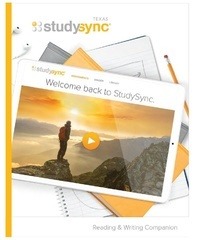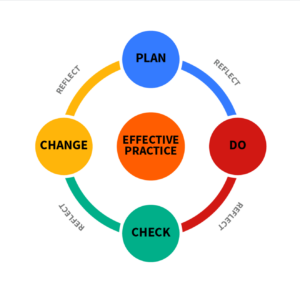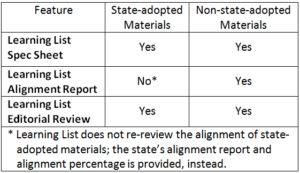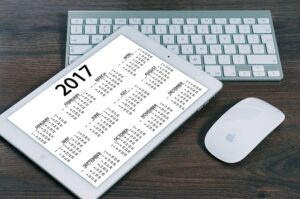During our many conversations regarding the alignment of instructional materials we have found that the concept of curriculum alignment and even the phrase “aligned to standards” means different things to different people. For example, the marketing director of a publishing company recently told us that “aligned to standards” in their marketing material means that their material generally addresses the concepts contained in the standards. In contrast, when we ask educators what they understand when they read that a material is “aligned to standards,” they repeatedly tell us they expect the material to address the content knowledge and skills the standards require students to learn.
Standards Alignment
Posts about why alignment matters and how to align instructional materials, including assessments, to state or national standards
New Product Review: McGraw Hill Texas StudySync
Learning List recently reviewed McGraw Hill’s Texas StudySync, which was submitted for state adoption in Texas in response the Texas Education Agency’s  Proclamation 2019 call for K-8 English language arts and reading (ELAR) products aligned to the new ELAR Texas Essential Knowledge and Skills (TEKS). StudySync is a comprehensive product that supports English language arts/reading (ELAR) instruction in grades 6-12. Content is available in print and digital formats and is intended for blended learning environments. Learning List reviewed online resources for grades 6-8. Instruction centers on the close reading of a set of thematically-related texts with integrated lessons in reading comprehension, writing, and speaking and listening skills.
Proclamation 2019 call for K-8 English language arts and reading (ELAR) products aligned to the new ELAR Texas Essential Knowledge and Skills (TEKS). StudySync is a comprehensive product that supports English language arts/reading (ELAR) instruction in grades 6-12. Content is available in print and digital formats and is intended for blended learning environments. Learning List reviewed online resources for grades 6-8. Instruction centers on the close reading of a set of thematically-related texts with integrated lessons in reading comprehension, writing, and speaking and listening skills.
StudySync’s content is organized in six, 30-day thematic units at each grade level. Each unit focuses on an essential question and a genre. Most units address personal topics (e.g., “No Risk, No Reward”) and include content that relates to other subject areas, particularly social studies. Units integrate authentic literary and informational texts and culminate in an overarching project that requires students to respond to what they have read in either written or spoken format. Across middle school grades, texts vary in length and genre and address diverse individuals and cultures. [Read more…]
Defining Roles: Standards vs. Curriculum vs. Instructional Materials
 Educators and publishers often use the terms “standards,” “curriculum” and/or “instructional materials” interchangeably. Moreover, many educators consider their instructional materials to be their curriculum. However, each of these terms represents a distinct component of an educational program. In the sections that follow, we provide explanations of each of these terms to differentiate their meanings in the context of PreK-12 education.
Educators and publishers often use the terms “standards,” “curriculum” and/or “instructional materials” interchangeably. Moreover, many educators consider their instructional materials to be their curriculum. However, each of these terms represents a distinct component of an educational program. In the sections that follow, we provide explanations of each of these terms to differentiate their meanings in the context of PreK-12 education.
Standards set out what students are expected to know and be able to do at the end of each school year. Standards are generally established at the state level. In fact, ESSA requires that each state create learning standards for public schools in three subjects—English language arts/reading, mathematics, and science—and many states go beyond ESSA’s minimum to set standards in social studies, career and technical education, languages other than English, and other subjects.
In contrast, the curriculum is developed at the district level, the product of local policy making. While the standards tell you what is expected, the curriculum provides the road map to get there. Often described in documents such as “scope and sequence” and “units of instruction,” a curriculum includes goals, instructional practices and pedagogical guidance, suggested resources and instructional materials, and methods of measuring student progress. [Read more…]
4 Ways to Use Materials to Achieve Student Learning Objectives
Solid instruction begins with an analysis of student data followed by the development of targeted learning objectives/goals and instructional practices aimed at achieving them. District curriculum documents identify high-level learning objectives. Student Learning Objectives/Outcomes (SLOs) are growth targets set by teachers to help them plan instruction and drive learning throughout the year. SLOs are guided by the district curriculum and based on student data. SLOs also provide schools and districts with a way to make best instructional practice a common expectation for all teachers.
Here are four ways teachers can use their materials to achieve SLOs:

(1) After the focus of an SLO has been identified, check for causal connections between students’ learning deficits and deficits in the alignment of the district/campus’ instructional materials you have been using. Verify the alignment of any citations (lessons, activities, quizzes) you are planning to use to the standards students are struggling with.
- Learning List’s alignment report for each material identifies which citations listed in the publisher’s correlation are aligned to each standard and which citations are not aligned.
(2) Use your existing materials to scaffold instruction from prior grade levels to address learning gaps that have persisted over multiple grade levels.
- Learning List’s alignment comparison tool and alignment report for each grade level make it easy for teachers to identify citations in their existing materials that are aligned to the standards students are struggling with at any grade level. [Read more…]
What to Expect from Supplemental Materials
A supplemental resource is designed to complement and support comprehensive materials. Publishers design supplemental resources for different purposes, including to:
- help students learn the content and practice the skills contained in all of the standards for a particular grade and subject;

- offer some of the same resources as comprehensive materials to support students in learning a specific subset of standards (e.g., writing standards, Personal Financial Literacy, etc…);
- target specific standards with which students typically struggle;
- build skills addressed across grade level standards; or
- support specific student learning needs, such as the needs of English language learners, students with disabilities, or advanced learners.

Supplemental materials vary in the percentage of standards they intend to address. Some intend to align to all grade-level standards, but most do not. A supplemental resource that is aligned to only 50% of the grade-level standards may be the best material to select if it is aligned to the standards you need it to teach. Similarly, a resource that intends to build vocabulary may do so effectively even though it is aligned to fewer than 10% of the grade level standards because it does not teach the other content and skills the standards require. Thus, such a product may be a great addition to your district’s instructional arsenal despite its low alignment percentage. [Read more…]
Updates to Advanced Placement Course Frameworks

The College Board recently updated the course frameworks for several of the Advanced Placement courses for which Learning List has reviewed materials. We have worked with the College Board to revise our alignment templates to reflect the following changes:
AP History Disciplinary Practices and Reasoning Skills
- The Historical Thinking Skills were reorganized and renamed “AP History Disciplinary Practices and Reasoning Skills.” The number of practices and skills were reduced. There are now two practices and four skills. “Periodization” and “Synthesis” were eliminated as separate skills.
- The revised “AP History Disciplinary Practices and Reasoning Skills” are part of the frameworks for AP US History, AP World History, and AP European History. [Read more…]
Frequently Asked Questions About Learning List
As the school year shifts into high gear, we are getting a lot of questions about our service. Here are answers to the most frequently asked questions.
What is Learning List?
Learning List is a subscription-based
 We created Learning List in 2013 to help districts become better informed consumers of instructional materials. Initially, districts used our reviews to facilitate their selection of materials. Over time, subscribers began telling us that our reviews also helped them identify the best parts of their existing materials to use to teach each standard. As one instructional coach explained, “We use your alignment reports as a GPS through our materials to ensure that we’re using the pages that teach each standard fully.”
We created Learning List in 2013 to help districts become better informed consumers of instructional materials. Initially, districts used our reviews to facilitate their selection of materials. Over time, subscribers began telling us that our reviews also helped them identify the best parts of their existing materials to use to teach each standard. As one instructional coach explained, “We use your alignment reports as a GPS through our materials to ensure that we’re using the pages that teach each standard fully.”
What types of materials do you review?
We have reviewed over 2500 of the most widely used instructional materials, including:
- Materials in the four core subjects, 12 Advanced Placement courses, Tech Apps and 85 CTE courses;
- Comprehensive and supplemental materials, including RtI, testprep, criterion-referenced test banks, and professional development resources;
- Publisher produced and free open educational resources (OERs);
- State-adopted and non-adopted materials (i.e., materials that were not submitted for state adoption); and
- English and Spanish versions of materials.
Subscribing districts get access to all published reviews and may request reviews of additional materials as part of the subscription. That’s why Learning List is a service, not just a website. [Read more…]
What Should You Expect From Test Prep Materials?
 Over the last five years, we have learned a lot about instructional materials. One observation is that comprehensive and supplemental materials, including RtI and test prep resources, are designed very differently and are intended for different purposes. Another observation is that unless you use a material for its intended purpose, it is unlikely you will achieve the result you need.
Over the last five years, we have learned a lot about instructional materials. One observation is that comprehensive and supplemental materials, including RtI and test prep resources, are designed very differently and are intended for different purposes. Another observation is that unless you use a material for its intended purpose, it is unlikely you will achieve the result you need.
Meeting Students’ Learning Needs: Alignment Information Supports Selection of Materials for Differentiation
 Have you ever been frustrated when attempting to plan differentiated lessons? Though “differentiation” is a rather simple concept, it is complex to implement successfully.
Have you ever been frustrated when attempting to plan differentiated lessons? Though “differentiation” is a rather simple concept, it is complex to implement successfully.
Most teachers understand that any resource used to differentiate instruction must have the requisite adaptions for the students being taught. For example, materials being used to teach ELLs should have multi-lingual glossaries, linguistic accommodations, and culturally relevant examples and activities to engage ELL students. Materials being used to engage Gifted and Talented students would have extension/ enrichment activities, higher-level questions, and options for inquiry-based learning. And, for RtI, the materials should have options for each tier of intervention. [Read more…]
5 Ways Learning List’s Alignment Reports Can Inform Your Instruction
When reviewing the alignment of a material, our subject matter experts review multiple citations (e.g., pages, lessons, videos) listed in the publisher’s correlation for alignment to each state standard. For some products, this means that Learning List will have reviewed all of the citations listed in the publisher’s correlation; for others, it means that Learning List has reviewed several but not all of the publisher’s citations.
We constructed our review methodology to balance subscribers’ need for a thorough review against their need for a timely review. Some publishers list more than 20 citations as aligned to each standard. If we were to review all of the listed citations, it would take months instead of weeks to complete a review, and educators told us that the resulting alignment reports would be too cumbersome to use.
their need for a timely review. Some publishers list more than 20 citations as aligned to each standard. If we were to review all of the listed citations, it would take months instead of weeks to complete a review, and educators told us that the resulting alignment reports would be too cumbersome to use.
A subscriber once asked, “Do you think that the fact you don’t review all of the citations in the publisher’s correlation diminishes the usefulness of your service?” Even though we have not reviewed every citation listed in the publisher’s correlation, our alignment reports help educators focus on the parts of the material that will give them the greatest instructional value. [Read More …]